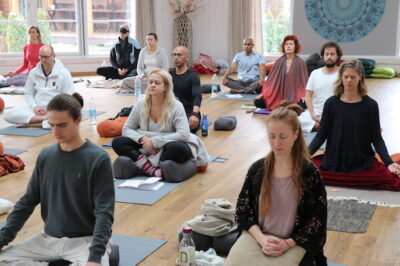Why is Silence Important in a Yoga Retreat?
12 July Jul 2017
In spiritual traditions there are various tools that may be used to gain deeper and more profound results in one’s practice. One way to take your spiritual self-inquiry to a more intense level is to practice mauna.

In the Sanskrit language, mauna means silence of the mind or taking a vow of silence, and the purpose of it is quite simple – to disconnect.
In the Hindu tradition, silence has a voice of its own. What does that mean, practically speaking?
Essentially, silence can speak volumes, even more so than the written or spoken word. This is especially true for an individual who practices abstinence in communication for an extended period of time. This profound experience can bring great clarity, inner transformation, self-revelation, and self-luminosity.
Liberation Through Silence
In our day-to-day lives we unconsciously mirror others in our behavior, invariably searching for cues as to how to live and respond to our world appropriately.
We become master chameleons – constantly molding and grafting our behavior according to our perceived expectations of the world around us. This way of life leads us further and further away from our true nature – our inner self.
“Silence is not silent. Silence speaks. It speaks most eloquently. Silence is not still. Silence leads. It leads most perfectly.” ~ Sri Chinmoy

In brief, practicing mauna does not mean you just avoid talking. It also means complete disengagement from everything but the self.
There must be no talking, no visual or physical cues between yourself and others, and not even deliberate eye contact. Of course exceptions are usually made in the event of an emergency or when a student needs guidance from a teacher.
With strict adherence to the rules and guidelines of mauna, which are described in more detail during specific meditations or retreats, a person is thrown into the deep waters of silence and reflection immediately. This experience can be a bit intimidating, especially at first, but in time one learns to enjoy the newfound liberation that complete silence brings.
The 4 Stages Of Mauna
Usually, people can expect to go through four stages when mauna is observed during a meditation or Yoga retreat.
- Foreignness, awkwardness – This is a good sign and simply signifies that you have started to go deeper and your mind is trying to rebel. You might still accidentally greet people, but it is fine for now.
- Frustration – You can’t talk or vent to anyone and your mind may be bursting with many things

Pictured here are student’s in meditation at our New Year’s Retreat. you’ve had to process by yourself. Not to worry – you can get through it.
- Learning – Self-absorption becomes self-observation. You begin to reflect upon yourself rather than outside sources or stimuli.
- Calm – You’ve let go of external influences and arrived at a place of acceptance.
As you practice mauna, whether in a meditation retreat or perhaps as a practice one day per week, you begin to realize you are more than your thoughts and there is something else that is the real YOU.
Thoughts are mere ripples on a lake, and the ripples do not define the lake. When silence overtakes the mind it becomes still and something extraordinary emerges as a result: the ability to perceive and conceive beyond your conditioned mind.
Suddenly your true self, your soul or inner atman, has a place to shine through and, in this space, it is acknowledged and recognized by the higher mind.

Somananda
Founder and Head Teacher
Spiritual yogi, lecturer, teacher and author, Somananda is the founder and head teacher of Somananda Tantra School.

Recommended Course

The Highest Tantra: Kashmiri Shaivism Retreat
The yoga of enlightenment
